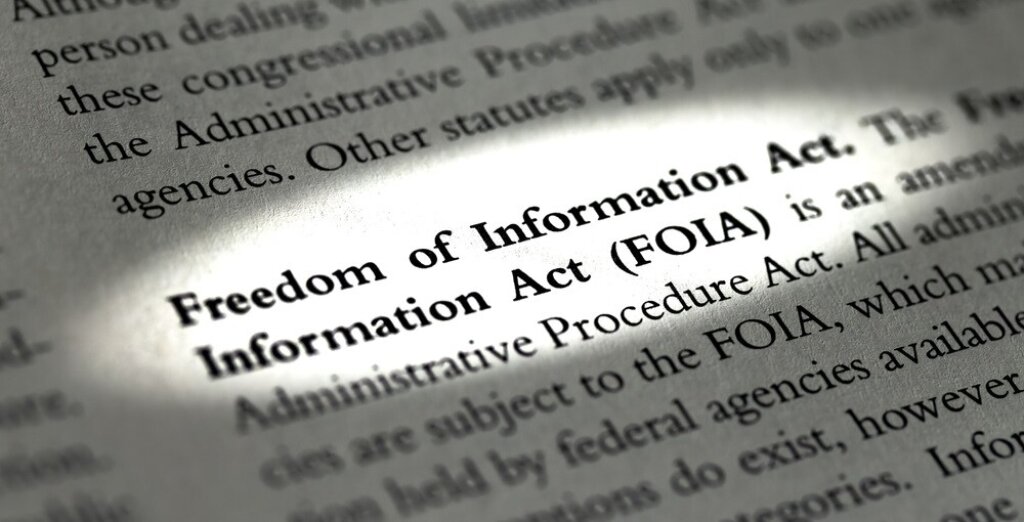Automated Freedom of Information Redaction Software Insights
In this article, we look at the importance and purpose of the Freedom of Information Act and the critical role of redaction (data masking) when sharing information to protect sensitive data in documents and video footage.
Background and Purpose of FOIA
The Freedom of Information Act (FOIA), enacted in the United States in 1966, serves as a cornerstone of government transparency. It grants the public the right to request access to records from federal agencies to ensure accountability and openness in government operations.
Over the years, FOIA has inspired similar transparency laws globally, which reflects its foundational importance in democratic governance.

Milestones in FOIA's Evolution include:
1974 Amendments strengthened FOIA by improving the appeals process and imposing time limits for agency responses.
The 1996 Electronic Freedom of Information Act (E-FOIA) extended FOIA's reach to electronic records, reflecting the growing importance of digital communication.
The 2007 OPEN Government Act enhanced agency compliance and introduced penalties for non-responsiveness.
The 2016 FOIA Improvement Act mandated greater transparency, such as requiring agencies to make frequently requested records publicly available online.
Freedom of Information in the UK
The Freedom of Information Act (FOI) in the UK, enacted in 2000, grants individuals access to public authority information. In the digital age, FOI tools are playing a pivotal role in transforming how local government manages information requests.
FOI tools include specialised software solutions that streamline request processes and enable information to be shared without compromising the privacy rights of individuals or revealing proprietary or sensitive information.
Key advantages include automation and the ability to handle diverse information formats, including documents and video footage.
The digitisation of FOI processes not only expedite responses but also contribute to cost savings and resource optimisation, which enables staff to focus on more impactful tasks.
Purpose of FOIA
FOIA has a dual purpose, namely, to foster transparency while protecting sensitive information. This dual mandate ensures a balance between public access and privacy, national security and other critical interests.
In essence, FOIA represents the public's "right to know," which is intended to foster trust and participation in government while ensuring sensitive matters remain protected. Its enduring relevance highlights the ongoing need for a transparent yet secure flow of information in modern democracies.
Understanding FOI Redaction and Its Importance
The Freedom of Information Act (FOIA) is a cornerstone of transparency in governance that allows public access to government records while safeguarding sensitive information.
As organisations strive to meet FOIA compliance, the redaction process becomes pivotal. Effective redaction ensures sensitive details like personal identifiers, classified data and proprietary information are obscured in order to balance transparency with privacy.
However, the stakes are high: errors in redaction can lead to legal ramifications, data breaches and erosion of public trust.
Data breach risks underscore the need for robust and reliable redaction solutions, particularly as the volume of FOIA requests continues to grow.
Common Challenges in FOI Redaction
Redacting documents is often fraught with challenges, including:
Time-Consuming Processes
Handling large volumes of documents or videos manually can be labour-intensive and delay responses.Human Error
Even experienced professionals can overlook sensitive information or miss details in video footage, which risks compliance breaches.Resource Constraints
Smaller organisations may lack dedicated teams, which stretches resources very thin.Complexity of Data
Modern documents can contain embedded metadata or mixed formats that are difficult to identify and redact manually. Videos contain more personal data than obvious faces, such as name tags, vehicle, licence plates and distinguishing marks.
These challenges highlight the limitations of traditional redaction methods and the need for technological solutions.
Manual vs Automated Redaction
Drawbacks of Manual Redaction
Inconsistency
Reliance on human judgment can lead to inconsistent redaction standards.Vulnerability to Oversights
Errors can expose sensitive data, which leads to financial and reputational damage.High Costs
Labour-intensive manual processes can strain budgets, especially for high-volume requests.
Advantages of Automated Redaction
Efficiency
Automated tools can process documents rapidly to meet tight FOIA deadlines.Accuracy
Leveraging advanced algorithms minimises the risk of exposing sensitive information.Scalability
Automated solutions handle large datasets seamlessly to ensure consistent results.
By shifting to automation, organisations can achieve greater precision and efficiency in FOI compliance.
Key Features of Automated Document Redaction Software
When evaluating automated redaction tools, organisations should consider the following key features:
Machine Learning Capabilities
Advanced algorithms that learn from patterns to identify and redact sensitive data across varied formats.Customisable Redaction Rules
The ability to tailor rules based on specific regulatory requirements or organisational needs.User-Friendly Interface
Intuitive platforms that require minimal training for staff.Audit Trails
Comprehensive logs to ensure transparency and accountability.Integration Capabilities
Seamless integration with existing document and/or video management systems in order to streamline workflows.
Such features empower organisations to handle FOIA requests with confidence and precision.
Case Study: Successful Redaction Implementation
A government agency faced a growing backlog of FOI requests and was struggling with manual redaction processes. After implementing an automated redaction solution, they achieved remarkable improvements:
Increased Efficiency
Processing times reduced by 70%.Improved Accuracy
A significant drop in redaction errors.Enhanced Compliance
Audit-ready logs ensured adherence to FOI requirements.
The agency not only cleared their backlog but also established a scalable system to handle future requests efficiently.
Best Practices for Effective FOI Redaction
To optimise FOI redaction processes, organisations should adopt these strategies:
Invest in Training
Equip staff with the skills to operate redaction tools effectively.Standardise Procedures
Establish clear protocols for identifying and redacting sensitive data.Leverage Technology
Use automated solutions to enhance accuracy and reduce workload.Conduct Regular Audits
Periodically review redaction practices to ensure compliance and efficiency.Plan for Scalability
Prepare for increasing FOIA demands with adaptable solutions.
These practices can transform redaction from a burdensome task into a streamlined process.
The Future of FOI Redaction
As technology evolves, so does the potential for FOI redaction. Emerging trends include:
AI-Driven Analysis
Enhanced machine learning models that improve redaction precision.Natural Language Processing (NLP)
Better identification of sensitive data in unstructured text.Data Visualisation
Tools that provide insights into redaction trends and compliance metrics.
The integration of these advancements will revolutionise data privacy and ensure FOIA compliance in a rapidly changing world.
Facit FOI Redaction Solutions
Simplify your FOI compliance efforts with Facit automated document redaction and video redaction solutions. Discover how our cutting-edge, AI-driven technology can help your organisation achieve greater efficiency, accuracy and compliance in handling sensitive information.
Contact us today to learn more.
Related Articles
Cloud Vs In-House Document Redaction



